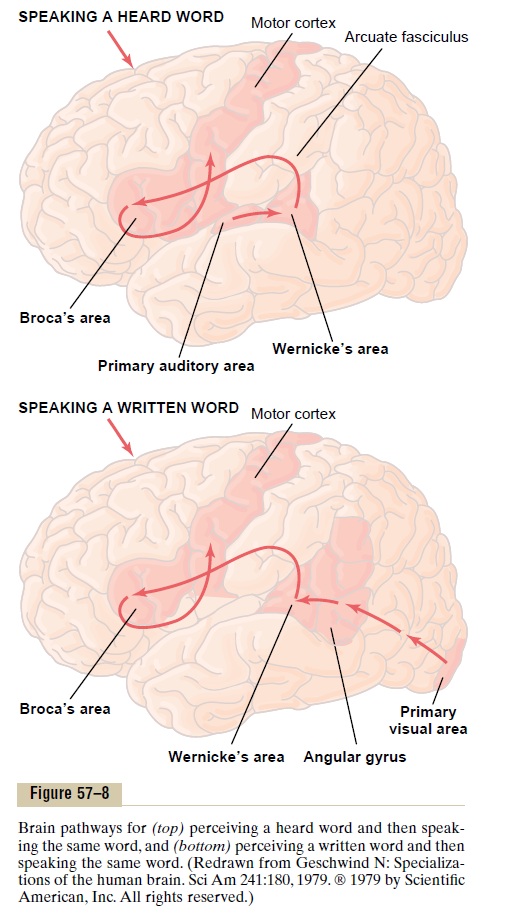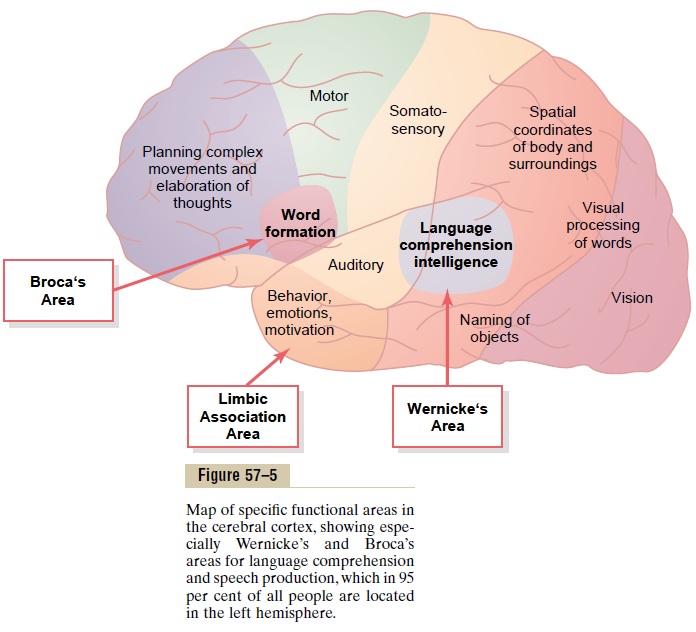Chapter: Medical Physiology: Cerebral Cortex, Intellectual Functions of the Brain, Learning and Memory
Function of the Brain in Communication-Language Input and Language Output
Function of the Brain in Communication-Language Input and Language Output
One of the most important differences between human beings and lower animals is the facility with which human beings can communicate with one another.

Furthermore, because neurological tests can easily assess the ability of a person to communicate with others, we know more about the sensory and motor systems related to communication than about any other segment of brain cortex function. Therefore, we will review, with the help of anatomical maps of neural path-ways in Figure 57–8, function of the cortex in commu-nication. From this, one will see immediately how the principles of sensory analysis and motor control apply to this art.
There are two aspects to communication: first, the sensory aspect (language input), involving the ears andeyes, and, second, the motor aspect (language output), involving vocalization and its control.
Sensory Aspects of Communication. We noted earlier that destruction of portions of the auditory or visual association areas of the cortex can result in inabil-ity to understand the spoken word or the written word.
These effects are called, respectively, auditory receptiveaphasia and visual receptive aphasia or, more commonly, word deafness andword blindness (also called dyslexia).
Wernicke’s Aphasia and Global Aphasia. Some peopleare capable of understanding either the spoken word or the written word but areunable to interpret the thought that is expressed. This results most frequently when
Wernicke’s area in the posterior superior temporal gyrus in the dominant hemisphere is damaged or destroyed.Therefore, this type of aphasia is called Wernicke’saphasia.
When the lesion in Wernicke’s area is widespread and extends (1) backward into the angular gyrus region, (2) inferiorly into the lower areas of the temporal lobe, and (3) superiorly into the superior border of the sylvian fissure, the person is likely to be almost totally demented for language understanding or communica-tion and therefore is said to have global aphasia.
Motor Aspects of Communication. The process of speechinvolves two principal stages of mentation: (1) forma-tion in the mind of thoughts to be expressed as well as choice of words to be used and then (2) motor control of vocalization and the actual act of vocalization itself.
The formation of thoughts and even most choices of words are the function of sensory association areas of the brain. Again, it is Wernicke’s area in the posterior part of the superior temporal gyrus that is most impor-tant for this ability. Therefore, a person with either Wer-nicke’s aphasia or global aphasia is unable to formulate the thoughts that are to be communicated. Or, if the lesion is less severe, the person may be able to formu-late the thoughts but unable to put together appropri-ate sequences of words to express the thought. The person sometimes is even fluent with words but the words are jumbled.
Loss of Broca’s Area Causes Motor Aphasia. Sometimesa person is capable of deciding what he or she wants to say but cannot make the vocal system emit words instead of noises. This effect, called motor aphasia, results from damage to Broca’s speech area, which lies in the prefrontal and premotor facial region of the cere-bral cortex—about 95 per cent of the time in the left hemisphere, as shown in Figures 57–5 and 57–8. There-fore, the skilled motor patterns for control of the larynx, lips, mouth, respiratory system, and other accessory muscles of speech are all initiated from this area.

Articulation. Finally, we have the act of articulation,which means the muscular movements of the mouth, tongue, larynx, vocal cords, and so forth that are respon-sible for the intonations, timing, and rapid changes in intensities of the sequential sounds.The facial and laryn-geal regions of the motor cortex activate these muscles,and the cerebellum, basal ganglia, and sensory cortex all help to control the sequences and intensities of muscle contractions, making liberal use of basal ganglial and cerebellar feedback mechanisms. Destruction of any of these regions can cause either total or partial inability to speak distinctly.
Summary. Figure 57–8 shows two principal pathways forcommunication. The upper half of the figure shows the pathway involved in hearing and speaking. This sequence is the following: (1) reception in the primary auditory area of the sound signals that encode the words; (2) interpretation of the words in Wernicke’s area; (3) determination, also in Wernicke’s area, of the thoughts and the words to be spoken; (4) transmission of signals from Wernicke’s area to Broca’s area by way of the arcuate fasciculus; (5) activation of the skilled motor programs in Broca’s area for control of word for-mation; and (6) transmission of appropriate signals into the motor cortex to control the speech muscles.
The lower figure illustrates the comparable steps in reading and then speaking in response.The initial recep-tive area for the words is in the primary visual area rather than in the primary auditory area. Then the infor-mation passes through early stages of interpretation in the angular gyrus region and finally reaches its full level of recognition in Wernicke’s area. From here, the sequence is the same as for speaking in response to the spoken word.
Related Topics